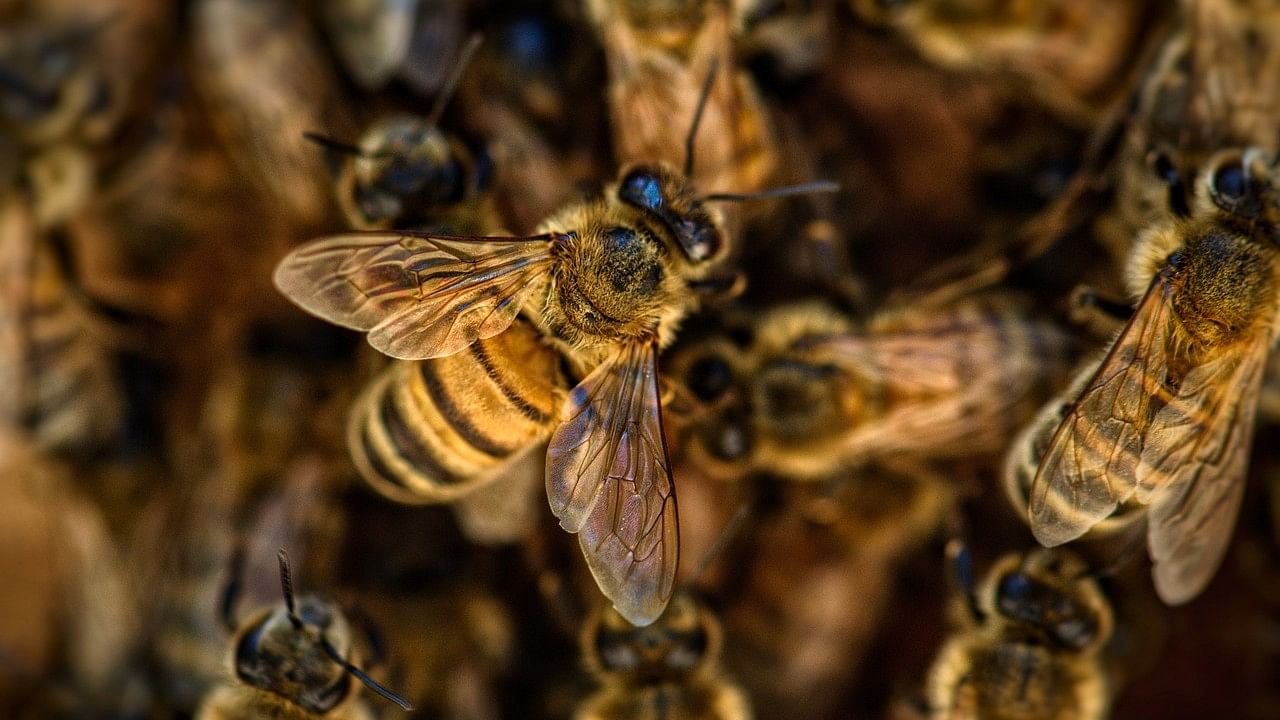
Representative image of bees.
Credit: Pixabay Photo
The number of insects hitting one's car's windshield has drastically reduced in recent years. This number is a rough indicator of the density of insects present around us. Over the past three decades, various countries, including Germany and North America, have reported a decline of over 50 per cent in their insect populations. Conservation efforts, however, prioritise large charismatic species, overlooking those that contribute significantly to the Earth's biomass — insects.
Insect apocalypse
While there is an ongoing debate about what most negatively affects insect populations, habitat conversion, use of agrochemicals, and Climate Change are at the top of the list. A convergence of such factors resulted in a scenario that can now be described as an 'insect apocalypse'.
While some species are pests to farmers, they are crucial pollinators for most flowering plants, including ~70 per cent of fruits and vegetables we eat. Many birds rely on them as a food source, making them critical links in the food web. Various species of bees, flies, butterflies, moths, and beetles play an essential role in pollination.
Rapid changes in modern agriculture to meet the needs of a growing population influence pollinator populations. We have transitioned from small intercropping to large monocultures with the heavy use of fertilisers and pesticides to boost crop productivity. A new wave of chemicals is being introduced annually to combat pests and resistant strains.
Discussions and decisions centred on agricultural practices, such as the introduction of new fertilisers and pesticides, must include their potential impacts on pollinators. Insect pollinators may be exposed to pesticides when they fly over fields or feed on plants with contaminated nectar and pollen.
The impacts of such pollution can result in a range of negative effects on them, including changes in behaviour such as finding their nests, reduced reproductive capacity, and weakened immune systems. For social insects, such as bees, the impacts can lead to the collapse of entire colonies.
Studies have reported that pesticide exposure could also lead to disrupted communication in the colony and errors in the well-known honeybee dance language. Currently, new methods are being developed to conduct rapid assessments of the risks and consequences of exposure to agrochemicals on flower-visiting insects.
It is essential to quantitatively evaluate the advantages and disadvantages of agrochemical use on the environment and human health. The spread and growing market for organically-farmed produce suggests the acceptance of their positive impact on human health. Along similar lines, the health of pollinators visiting flowers in organic farms is also being studied.
A study in Western Washington revealed the positive relationship between bee community stability and practices such as crop diversification and organic farming land usage. While organic farms have increased in number, implementation of integrated pest management strategies, such as using biocontrol agents, decoy crops, or weeds to repel harmful insects, is yet to be widespread in the tropics.
The decline in bee numbers could cause irreversible crises. Researchers from the University of Calcutta found that Asiatic honeybee colonies placed in agricultural fields that used pesticides showed reduced ability to detect odours. Similarly, work done in China showed that exposure to field-realistic levels of Flupyradifurone, a pesticide, reduced the ability of these bees to associate odour with food. It is vital for bees to form groups to locate food.
The way forward
Further examination is needed to determine how non-social bees and other pollinators are affected, as most studies have focused on honeybees. Stingless bees are important pollinators of many tropical crops. A recent review highlights these impacts on non-honeybee species. While the routes of exposure are similar for all pollinators, non-honeybee species differ in their foraging ranges and aspects of growth and development. These differences prevent us from making conclusions by studying honeybee species as surrogates.
Apart from identifying the risk factors that may result in a decrease in pollinator numbers, it is crucial to document the changes in numbers across space and time. Part of the handicap in putting forth generalisable pollinator-friendly practices comes from not having these actual numbers.
Another limitation lies in understanding how such chemical residues interact with ongoing climatic changes to affect native bees in both the short and long term. There have been isolated studies in India, such as one on pesticide residues in nectar and pollen of mustard fields from the Himachal region and a few from Karnataka and Kerala.
To combine such efforts of multiple pollination initiatives and advance pollination biology in India, The Indian Pollinator Initiative (InPollin) has been set up. By encouraging the involvement of students, conservationists, and nature enthusiasts, the initiative serves as a significant starting point for disseminating the importance of pollination and pollinator-friendly practices in urban and rural environments.
(Shivani Krishna is Assistant Professor of Biology, Ashoka University.)
Disclaimer: The views expressed above are the author's own. They do not necessarily reflect the views of DH.